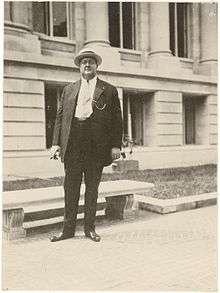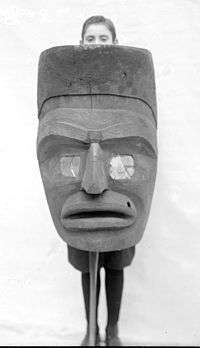George Gustav Heye
| George Gustav Heye | |
|---|---|
 Heye in 1917 | |
| Born | 1874 |
| Died | January 20, 1957 |
| Alma mater | Columbia University |
| Occupation | investment banker |
| Known for | Indigenous peoples of the Americas collector |
| Notable work | Museum of the American Indian |
George Gustav Heye (1874 – January 20, 1957) was a collector of Native American artifacts. His collection became the core of the National Museum of the American Indian.[1]
Life and career
Heye was the son of Carl Friederich Gustav Heye; and Marie Antoinette Lawrence of Hudson, New York. Carl was a German immigrant who earned his wealth in the petroleum industry.
George graduated from Columbia College (now Columbia University) in 1896 with a degree in electrical engineering. While superintending railroad construction in Kingman, Arizona in 1897, he acquired a Navajo deerskin shirt, as his first artifact.[2] He acquired individual items until 1903, then he began collecting material in larger numbers. In 1901, he started a career in investment banking that lasted until 1909. In 1915, Heye worked with Frederick W. Hodge and George H. Pepper on the Nacoochee Mound in White County Georgia. The work was done through the Heye Foundation, the Museum of the American Indian, and the Bureau of American Ethnology, and was some of the most complete work of the time including numerous photographs. In 1918, Heye and his colleagues published a report entitled The Nacoochee Mound In Georgia. He accumulated the largest private collection of Native American objects in the world. The collection was initially stored in Heye’s Madison Avenue apartment in New York City, and later in a rented room.
.jpg)
By 1908, he was referring to the collection as "The Heye Museum",[2] and he was soon lending materials for exhibit at what later became the University of Pennsylvania Museum of Archaeology and Anthropology in Philadelphia.[3] In 1916, he purchased from J. E. Standley of Ye Olde Curiosity Shop the collection of Alaskan Native artifacts that had won the gold medal for ethnological collections at the 1909 Alaska-Yukon-Pacific Exposition.[4] Eventually, the Heye collection was moved to the Heye Foundation’s Museum of the American Indian at 155th Street and Broadway, which broke ground in May 1916.[5] In 1919, he established the journal Indian Notes and Monographs.[5] The museum opened to the public in 1922,[6] and closed in 1994, when the Smithsonian Institution opened the Heye Center of the National Museum of the American Indian in the former Custom House in lower Manhattan. Heye died on January 20, 1957. He is interred in Woodlawn Cemetery in The Bronx, New York City.
Museum of the American Indian

Heye created the Museum of the American Indian in 1916 in New York City and was its director until 1956. His collection of Native American materials was gathered over a period of 45 years. This collection became the basis of the National Museum of the American Indian. The largest in the world, it contains over one million objects from Native Americans. It was transferred to the Smithsonian in 1989, and about a third of the original collection has been repatriated.[7] Artifacts were once stored in the Bronx along the I-95 Expressway corridor, until the land and building was sold, then cleared to make way for private housing.
Membership
- American Anthropological Association
- American Museum of Natural History
- American Geographical Society
- American Association for the Advancement of Science
- The Explorers Club serving twice as president from 1922 to 1925 and 1928 to 1930
Publications
- George G. Heye, Frederick W. Hodge, and George H. Pepper, The Nacoochee Mound in Georgia. New York: Museum of the American Indian, Heye Foundation, 1918.
See also
References
Notes
- ↑ "George Heye Dies. Authority on Indian Tribes Endowed a Foundation for Scientific Collections Respect for Customs". New York Times. January 21, 1957.
George Gustav Heye, founder of the Museum of the American Indian, died yesterday at his home in the Ritz Tower after a long illness. His age was 82.
- 1 2 Duncan 2001, p. 85.
- ↑ Duncan 2001, pp. 85–86.
- ↑ Duncan 2001, p. 85 et. seq..
- 1 2 Duncan 2001, p. 86.
- ↑ Duncan 2001, p. 92.
- ↑ "George Gustav Heye". National Museum of the American Indian. January 1, 1997. Retrieved 2010-07-07.
George Gustav Heye (1874-1957) was the founder of the Museum of the American Indian (1916) in New York City and served as its director until 1956. His personal collection of materials, gathered during a 45-year period, became the basis of the museum’s collection and is considered the most comprehensive in the world. It includes 1 million objects from indigenous peoples throughout the Western Hemisphere.
Bibliography
- Duncan, Kate C. (2001). 1001 Curious Things: Ye Olde Curiosity Shop and Native American Art. University of Washington Press. ISBN 0-295-98010-9.
- Redman, Samuel J. (2016). Bone Rooms: From Scientific Racism to Human Prehistory in Museums. Harvard University Press. ISBN 9780674660410.
External links
| Wikimedia Commons has media related to George Gustav Heye. |
- Biography on the site of the Smithsonian